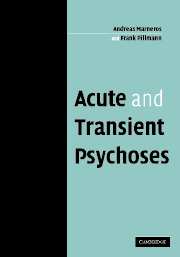Book contents
- Frontmatter
- Contents
- Preface
- Acknowledgements
- Part I History and concepts
- Part II Studies and findings
- Part III Issues of nosology
- 11 Defining the brief, acute and transient psychotic disorders: the polymorphic psychotic core
- 12 What are brief, acute and transient psychotic disorders?
- 13 Brief polymorphic psychoses as a component of a psychotic continuum
- References
- Index
13 - Brief polymorphic psychoses as a component of a psychotic continuum
from Part III - Issues of nosology
Published online by Cambridge University Press: 07 August 2009
- Frontmatter
- Contents
- Preface
- Acknowledgements
- Part I History and concepts
- Part II Studies and findings
- Part III Issues of nosology
- 11 Defining the brief, acute and transient psychotic disorders: the polymorphic psychotic core
- 12 What are brief, acute and transient psychotic disorders?
- 13 Brief polymorphic psychoses as a component of a psychotic continuum
- References
- Index
Summary
Diagnosis is a central task in psychiatry – clinically, determining the approach to treatment and the prognosis, and in research, identifying the population of interest. However, psychiatric diagnoses are based solely on clinical grounds with no external validating parameters. Furthermore, there are several determinants driving current diagnostic practice that may not be helpful to the needs of genetic and biological research (Crow, 1995; Mundt, 1995; Marneros et al., 1995a; Duffy and Grof, 2001).
Disease entities have to be determined by identical symptoms, course, aetiology and pathomorphology. The research process is meant to follow a constant approximation of this idea. Hence, as Mundt (1995) pointed out, outlining perspectives from a mere psychopathological point of view is a difficult task, since psychopathological validation of nosological concepts usually implies external validation with course, outcome, biological parameters, genetics and personality, and will probably result in outlining a type of mental disorganisation, perhaps inherent with its structure, rather than producing stringent mental concomitants of particular biological disturbances. Conventions rather than objective findings mark the borders, whereas only the extremes are very discriminating. It is therefore not surprising that the debate concerning the controversy of psychotic continuum versus separate entity is as old as the scientific psychiatry itself (Berrios and Beer, 1994).
A clear-cut dichotomy between schizophrenia and mood disorders – the two biggest and classical pillars of the so-called idiopathic or endogenous psychoses – does not exist. Even Kraepelin, the creator of the dichotomy of the psychoses, noted it in 1920.
- Type
- Chapter
- Information
- Acute and Transient Psychoses , pp. 206 - 209Publisher: Cambridge University PressPrint publication year: 2004



